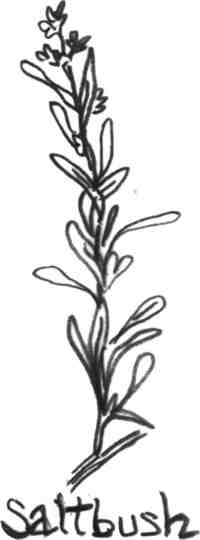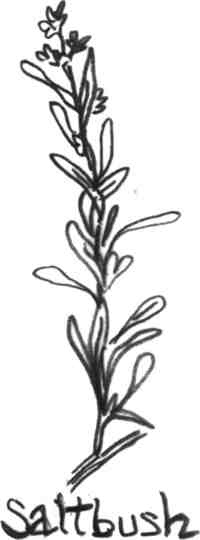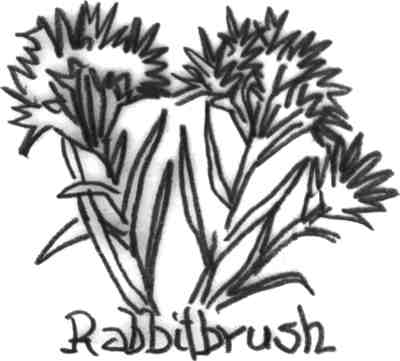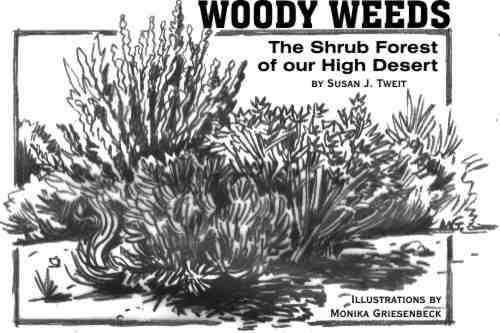Article by Susan Tweit
Local Botany – April 2007 – Colorado Central Magazine
DRIVE U.S. HIGHWAY 50 west from Salida, or take U.S. 285 the length of the San Luis Valley, and you’ll traverse mile after mile of seemingly mind- numbing high-desert shrubland. Aside from the mountains, the occasional towns, ranches, and farms, and the threads of forest edging streams and rivers, the landscape is a sea of shrubs: sagebrush on deeper, fertile soils, chamisa where sand dominates, and chico and fourwing saltbush where salts whiten the surface.

Although travelers view these tough shrubs as monotonous and ranchers and farmers eradicate them, these native species are in fact the ecological backbone of high-desert ecosystems. Like the forest canopy in nearby mountain ranges, their sparse overstory shades arid-country soil, providing insulation from both searing days and freezing nights. The polka-dot-pattern canopy of these shrubs also slows the wind, protecting the dry soil from erosion, retards evaporation of precious soil moisture, and traps airborne dust and detritus rich in organic matter and mineral nutrients.
Like a mini-forest, this shrub canopy also captures rain, channeling moisture down each trunk to filter into the soil instead of sheeting off the surface, and collects its own mini-snowdrifts in winter, caching moisture for the spring.
The dwarf overstory also helps protect the layer of micro- and macro- organisms that colonize the top several inches of desert soils, the sticky threads of fungus, the algae that fix nitrogen or photosynthize, the lichens and mosses. This microbiotic community we’ve only begun to know acts as a living sponge, binding the soil surface, and deters germination of invasive annual weed seeds. Remove the shrub canopy and the microbial crust goes too, leaving whole expanses of high-desert landscape truly deserted, their precious layer of thin soil blowing away in the wind.
The shrubs that today dominate high-desert valleys and basins may seem like weeds to some, but they are in fact pioneers whose roots on this continent go back at least 25 million years, since the turbulent eras when crustal plate-crashing thrust up the high ridges of the Sierra Nevada and Cascade Mountains, trapping inbound Pacific Ocean moisture and throwing the interior West into perennial, pore-puckering drought. As forests and their animal associates retreated to cooler, moister climates uphill, bunch grasses, shrubs and wildlife adapted to arid grasslands took over the basins between the mountain ranges.
THESE HIGH-DESERT SHRUBS may look alike at casual glance, all scruffy, their predominant color gray-green, with small leaves and twisting stems. But they’ve got very different “personalities” and they occupy characteristic ecological niches in the landscape.
Take chico and fourwing saltbush, the two halophytes, or salt-lovers, in the group. They’re both scraggly specimens with sparse leaf canopies. Both grow from around a foot to as much as six or eight feet high, and tolerate soils salty enough to kill most other plants. They store excess salt in their small, silver-green leaves — which taste distinctly salty and have been used to flavor foods. Both also belong to the same plant family as pigweed and goosefoot, as well as familiar garden beets and chard.

But there the resemblance ends. Chico is distinguished by the condition that inspires its scientific name, Sarcobatus vermiculatus — literally as “thorn-fleshed” and “worm-leaved” — a peculiar juxtaposition of succulent leaves that look like wriggly green worms borne on twigs which turn into spines when the leaves drop. Chico is also called greasewood for the “greasy” appearance of the soils where it flourishes: clay soils that alternate between suffocatingly wet and cracked bone dry, where the constant evaporation of desert climates concentrates the salts on the surface in white crusts that look like skiffs of never-melting snow.
Chico may not look like much, but this shrub’s adaptations to its problematic environment are positively elegant. Not only does it survive toxic salt concentrations (salt kills plants when it interferes with roots’ability to absorb water, causing the plants to essentially die of thirst), the shrub even uses the stuff as an antifreeze. The salt stored in chico’s fleshy leaves keeps ice crystals from forming in the leaf cells, protecting the evergreen leaves from frost damage and allowing the plant to produce food in winter when most other plants must go dormant.
Chico grows roots as deep as five stories underground, allowing it to tap groundwater supplies unavailable to other plants. And the shrub’s tiny flowers have a clever way to prevent self-pollination: in order to ensure mixing of genes, the male flowers on each plant bloom several weeks before the female flowers, so a plant cannot pollinate itself.
Despite both its salty leaves and those sleeve-slashing spines, wildlife from deer to desert cottontails and pocket mice avidly browse the young shoots of greasewood (the new growth is the least salty part of the plant). Eating too much of the shrub can poison sheep and cattle though, hence the perjorative label “weed.”
LIKE CHICO, fourwing saltbush also stores excess salts in its leaves, but it grows only on sandy soils that lack the abundant soil water that chico relies on to dilute the salts. So saltbush discards the stuff through special hair glands on its leaf surfaces. When these salt reservoirs are full, the bladder atop the hair bursts, excreting the salt outside the plant, where it can’t harm the shrub.

Named for the distinct salty tang that pervades its leaves and stems, saltbush was once widely used as a salt substitute, especially in pemmican, the energy-bar precursor made from pounded and dried meal, berries, and meat. The seeds of fourwing saltbush — which do, as the name says, sport four papery wings — are a favorite food of small wildlife, and the stems and leaves are important winter browse for desert animals and birds.
Like chico, fourwing saltbush flowers are sexist, either male or female. Unlike chico, however, saltbush goes one step farther and segregates the sexes on different plants, another strategy to assure cross-pollination. In situations where the shrubs are isolated, fourwing saltbush forgoes the benefits of gene mixing and turns transsexual, switching its flowers from male to female and back again.
In addition to their preference for different soil environments, the two halophytes can be distinguished by their appearance. Chico is usually taller than it is wide, with whitish bark, spiny twigs, and those queer wormlike leaves. Fourwing saltbush is rounded, wider than it is tall, densely branched, and its salt-secreting hairs give the leaves a silvery cast.
The only one of the four high-desert overstory shrubs that doesn’t form single-species stands, chamisa is best-known for the golden color it imparts to high-desert landscapes in late summer and early fall when its flat-topped clusters of small flowers burst into bloom. The shrub grows abundantly along roadsides, where it takes advantage of the runoff from the pavement, an unregulated water augmentation creating a situation that biologists call “roadside riparian.” Chamisa mixes with fourwing saltbush on sandy soils, or big sagebrush on more fertile soils. Even when not in bloom, chamisa’s vase-shaped silhouette is distinctive: the shrub’s upward-aiming branches terminate in a flat top as if sheared off by a zealous gardener.
Like most high-desert plants, chamisa has adapted to long periods of drought: its narrow, linear leaves reduce the potential for evaporation while retaining sufficient surface for photosynthesis, and its stems are covered with a felt of white hairs that provides shade, insulation, and further reduces water loss.
THIS SHRUB’S most distinctive characteristic, and the inspiration for both its English common name, rubber rabbitbrush, and its scientific name, Chrysothamnus nauseosus — literally “nauseous golden- shrub” — is the latex in its sap. To protect itself from the desert’s myriad and voracious grazers, the shrub fills its tissues with indigestible rubber. (The rubbery deterrent is only partially effective: Mule deer and elk still browse the flowers and leaves, and a species of metallic blue-green beetle has adopted bacteria which can digest the latex, allowing the beetle to quickly defoliate the shrub.) With a latex content of 20 percent, chamisa has been used in the production of natural rubber.
It also manufactures hydrocarbon resins for insecticides and fungicides; teas made from the boiled leaves and stems have been used to treat fungal skin infections. Boiling the flowers produces a strong yellow dye, and their abundant golden pollen and nectar attracts clouds of butterflies, along with crab spiders, which hide in the flower clusters to snatch unwary nectar- feeders for dinner.
Chamisa and sagebrush are both pungent, both have a whitish or silvery cast to their foliage, and they are cousins in the sunflower family. Beyond those similarities, however, the two shrubs are as unlike as family members can be. While chamisa rarely dominates the shrub canopy of the high desert, sagebrush is celebrated in song and story as the emblem of an entire region, the cold and dry inland West.
BIG SAGEBRUSH, as the shrub is properly called to distinguish the tall, single-trunked species from its smaller cousins, is the most widely distributed shrub in North America. It is exclusively a westerner, spreading in monochromatic “seas” from the western Great Plains to the coast ranges, and from the northern Southwest to southern Canada.
It’s the shrub that dominates whole dry basins and valleys with its even-height, silver-green canopies of small, three-tipped evergreen leaves and dense spikes of insignificant flowers. Its twisting stems rise from two to eight feet tall depending on the environment, with gray, peeling bark that makes flammable tinder and strong twine. And it is the source of the fragrance that evokes the arid west, a characteristic odor most often described as a mix of turpentine and camphor with an overtone of citrusy sweetness.

Sniff a sprig of sagebrush and your nose fills with the shrub’s chemical vocabulary, its means of communication with other species. The medicinal odor is a warning to grazers that its tissues are inedible, flooded with aromatic compounds called terpenes that act as anti-microbial agents. Like all woody plants, big sagebrush’s twigs and leaves contain cellulose, the plant fiber that makes celery stringy and paper strong. The bacteria that live in grazer’s guts break down cellulose into its component sugars, but doing so requires long periods of fermentation in the multiple stomach chambers of plant-eating ruminents like elk, deer, and cows. Too much turpene-rich sagebrush can poison a ruminent’s digestive fauna, so that cattle and mule deer can actually starve to death with a belly full of food. That’s why mule deer sniff before they bite; the canny ungulates invariably choose to browse the shrubs with lower terpene levels.
We don’t usually think of behavior and communication as qualities of plants, but big sagebrush’s adaptations include aspects of both. Not only does the shrub “speak” to grazers with its terpene compounds, it uses other fragrant chemicals for communication. For instance, when voracious grasshoppers invade a big sagebrush community, the shrub sounds a chemical alarm, releasing an odorous air-raid siren that causes other nearby plant species to flood their tissues with undigestible compounds to discourage the invasion of hopping grazers. Big sagebrush also changes its behavior in response to environmental changes: the shrub re-orients its leaves over the course of a day to reduce sunburn and dehydration, and sheds its evergreen foliage in periods of killing drought, aiming to live to photosynthesize another day.
Big sagebrush is so ubiquitous that grazers have figured out how to exploit this food source despite its chemical defenses. The plump and tasty sage-grouse, for instance, eats so much sagebrush foliage that its digestive system includes a pair of sacs where the toxic terpenes are isolated and excreted in pungent, tarry droppings.
Hundreds of species of wildlife, from pronghorn antelope to eye-catching black and white sagebrush sheepmoths depend on expanses of sagebrush for food, shelter, and habitat. Some cannot survive without the pungent shrub. The tiny sagebrush lizard, for instance, only eats sagebrush-dwelling insects, while sage sparrows and sage thrashers nest only in the shrub’s evergreen canopy. Pygmy rabbits burrow under twisting trunks of old-growth sagebrush and winter on a diet of the shrub’s leaves and stems; and the emblematic sage-grouse, known for the males’ dramatic mating dances in spring, may walk tens of miles between windswept winter sagebrush range and summer habitat in moist sagebrush meadows.

NO WONDER THEN, that big sagebrush is considered an ecological pillar of its community. Despite that, the once-extensive seas of this characteristic high-desert shrub continue to shrink, burned in wildfires fueled by cheatgrass and other invasive annual weeds, sprayed in the mistaken belief that these shrub canopies are themselves weeds, and plowed up for farms and development.
The high desert’s four signature shrubs — sagebrush, chamisa, chico, and saltbush — appear to some as woody weeds that connote bleak and monotonous expanses. To me, these shrubs are the backbone of what Aldo Leopold called “the community of the land,” a unique dwarf forest emblematic of the sere and glorious landscapes we share.
Susan J. Tweit, who lives in Salida, began her career as a biologist studying ecosystems from the plants’ point of view and now writes about the community of species that animate western landscapes. Sample her books and listen to her weekly commentaries at http://susanjtweit.com.



